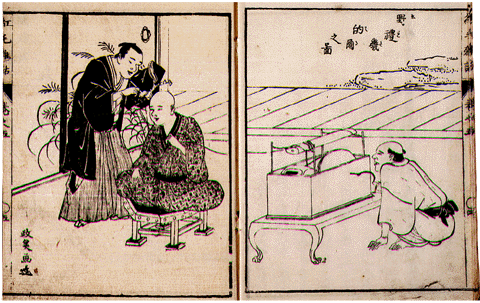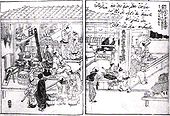
Elekiter
Encyclopedia


Japan
Japan is an island nation in East Asia. Located in the Pacific Ocean, it lies to the east of the Sea of Japan, China, North Korea, South Korea and Russia, stretching from the Sea of Okhotsk in the north to the East China Sea and Taiwan in the south...
, Hiraga Gennai
Hiraga Gennai
was an Edo period Japanese pharmacologist, student of Rangaku, physician, author, painter and inventor who is well known for his Erekiteru , Kandankei and Kakanpu...
presented his own elekiter in 1776, derived from an elekiter from Holland. The elekiter consists of a small box that uses the power of friction
Friction
Friction is the force resisting the relative motion of solid surfaces, fluid layers, and/or material elements sliding against each other. There are several types of friction:...
to generate electricity
Electricity
Electricity is a general term encompassing a variety of phenomena resulting from the presence and flow of electric charge. These include many easily recognizable phenomena, such as lightning, static electricity, and the flow of electrical current in an electrical wire...
and store it.
The Elekiter relied on the various Western experiments with static electricity during the 18th century, which depended on the discovery that electricity could be generated through friction, and on the invention of the Leyden jar
Leyden jar
A Leyden jar, or Leiden jar, is a device that "stores" static electricity between two electrodes on the inside and outside of a jar. It was invented independently by German cleric Ewald Georg von Kleist on 11 October 1745 and by Dutch scientist Pieter van Musschenbroek of Leiden in 1745–1746. The...
in the 1740s, as a convenient means to store static electricity in rather large quantities. Hiraga Gennai acquired an elekiter from Holland during his second trip to Nagasaki in 1770, and made a formal demonstration of his elekiter in 1776.

